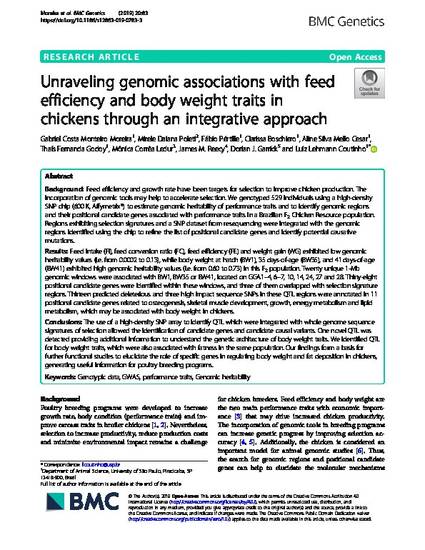
Background: Feed efficiency and growth rate have been targets for selection to improve chicken production. The incorporation of genomic tools may help to accelerate selection. We genotyped 529 individuals using a high-density SNP chip (600 K, Affymetrix®) to estimate genomic heritability of performance traits and to identify genomic regions and their positional candidate genes associated with performance traits in a Brazilian F2 Chicken Resource population. Regions exhibiting selection signatures and a SNP dataset from resequencing were integrated with the genomic regions identified using the chip to refine the list of positional candidate genes and identify potential causative mutations.
Results: Feed intake (FI), feed conversion ratio (FC), feed efficiency (FE) and weight gain (WG) exhibited low genomic heritability values (i.e. from 0.0002 to 0.13), while body weight at hatch (BW1), 35 days-of-age (BW35), and 41 days-of-age (BW41) exhibited high genomic heritability values (i.e. from 0.60 to 0.73) in this F2 population. Twenty unique 1-Mb genomic windows were associated with BW1, BW35 or BW41, located on GGA1–4, 6–7, 10, 14, 24, 27 and 28. Thirty-eight positional candidate genes were identified within these windows, and three of them overlapped with selection signature regions. Thirteen predicted deleterious and three high impact sequence SNPs in these QTL regions were annotated in 11 positional candidate genes related to osteogenesis, skeletal muscle development, growth, energy metabolism and lipid metabolism, which may be associated with body weight in chickens.
Conclusions: The use of a high-density SNP array to identify QTL which were integrated with whole genome sequence signatures of selection allowed the identification of candidate genes and candidate causal variants. One novel QTL was detected providing additional information to understand the genetic architecture of body weight traits. We identified QTL for body weight traits, which were also associated with fatness in the same population. Our findings form a basis for further functional studies to elucidate the role of specific genes in regulating body weight and fat deposition in chickens, generating useful information for poultry breeding programs.
Available at: http://works.bepress.com/james_reecy/145/

This article is published as Moreira, Gabriel Costa Monteiro, Mirele Daiana Poleti, Fábio Pértille, Clarissa Boschiero, Aline Silva Mello Cesar, Thaís Fernanda Godoy, Mônica Corrêa Ledur, James M. Reecy, Dorian J. Garrick, and Luiz Lehmann Coutinho. "Unraveling genomic associations with feed efficiency and body weight traits in chickens through an integrative approach." BMC Genetics 20 (2019): 83. doi: 10.1186/s12863-019-0783-3.